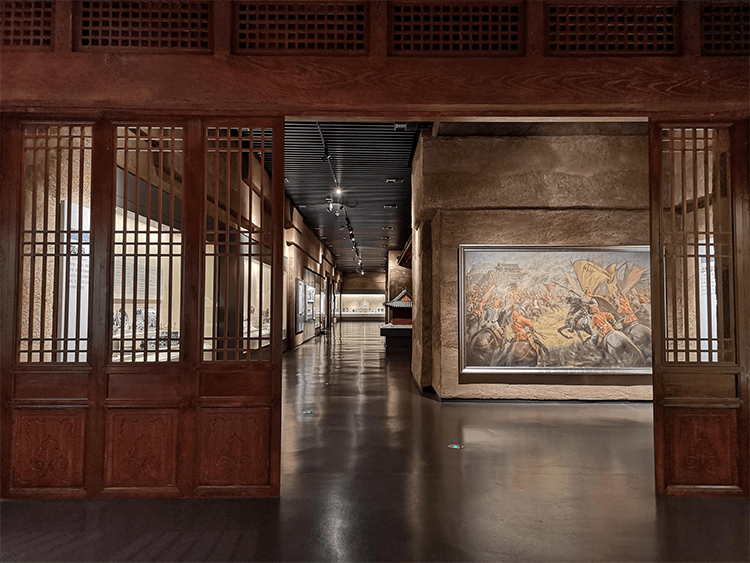Explore Kaifeng Museum and Ancient City Ruins — A Journey into the Song Dynasty
1. Intro: Touching Northern Song Elegance in a “City-on-City” Wonder
When sunlight filters through Song-style wooden lattice windows and falls on bluestone floors, the Kaifeng Museum seems to echo the distant pages of Dongjing Menghua Lu (A Record of Dreams of Splendor in the Eastern Capital). This national first-class museum acts like a precise time machine, compressing the memories of eight imperial eras into a 54,000-square-meter modern complex. Opened in 2018, the new building is itself a monumental artifact—its Song-style dougong brackets and the striking “city-on-city” bas-relief façade allude to the six buried city layers lying 3–12 meters underfoot. Here every object whispers the same secret: the daily life and sparkle of Northern Song’s Dongjing have never fully vanished.
2. Core Highlights: A Three-Dimensional Textbook of Song Aesthetics
As the largest integrated history museum in central China, Kaifeng Museum frames its narrative as “a Kaifeng history, half of Chinese civilization.” Of its 80,000 items, nearly half relate to the Song dynasty. Unlike many provincial museums, Kaifeng feels like an immersive theater: three flagship elements—the digital Qingming Shanghe Tu long scroll, artifacts from the Zhouqiao (State Bridge) site, and Northern Song official-kiln porcelain—combine to reconstruct an 11th–12th century metropolis from everyday street life and architectural marvels to imperial taste.
3. The Building Is the Exhibition
Designed by a Tsinghua University team, the new wing appears from afar as stacked scrolls. The most impressive feature is the east façade’s “city-on-city” art wall: 3D-printed cross-sections that render the Tang-era Bianzhou, Northern Song Dongjing, and Jin-era Bianjing city walls in layered relief. At certain times, sunlight casts shifting rings of light across the atrium floor that read like the museum’s own year-rings. The central hall’s “time-space tunnel” is clever: standing on the glass floor you look down into display cases arranged like archaeological trenches, where Han and Tang figurines sit above Ming and Qing porcelain—an intuitive, visual lesson in Kaifeng’s underground, stratified past.

4. Must-See Treasures
4.1 “Qingming Shanghe Tu” Immersive Theater (3rd-floor special gallery)
Different from the Palace Museum’s original-scroll presentation, Kaifeng’s immersive version uses a dynamic, high-definition digital scroll enlarged to twice life-size with immersive sound design. Stall vendors on Rainbow Bridge shout, and canal boats creak back to life. A day-night mode cycles every 20 minutes, showing urban scenes from dawn to curfew. Interactive screens let you zoom into more than 500 characters; delightfully, a delivery rider’s lunch box reveals Song-era sweets like “bingxue lengyuanzi”—a medieval local favorite turned social-media snack.
4.2 Stone Carvings from the Zhouqiao Ruins (2nd-floor Kaifeng history hall)
A major 2022 acquisition, giant Northern Song stone reliefs from the Zhouqiao site stun visitors: carved cranes, auspicious clouds and sea-beast motifs, each slab weighing up to three tonnes yet carved with delicate detail. AR scanning fills in missing fragments on your phone screen, reconstructing scenes recorded in Dongjing travelogues: “stone cliffs on both banks, carved with hippocamps and flying-cloud beasts.” Nearby cases hold copper “Jingde Yuanbao” cash coins still flecked with Bian River silt, an intimate physical link to Zhang Zeduan’s painted world.
4.3 Northern Song Official-Kiln Celadon Bottle (1st-floor treasures gallery)
Identified by Palace Museum experts as a rare surviving masterpiece, this celadon bottle glows like sky after rain. The fine crackled glaze refracts light with rainbow sheens. It embodies Emperor Huizong’s aesthetic shift and the “abandon Ding for Ru” debates of the period. A display of modern craft reproductions—intentional failures included—makes the original’s subtle perfection even more striking.
5. Smart, Visitor-Friendly Experiences
– Multilingual AR glasses (English, Japanese, Korean) automatically recognize key artifacts and use 3D animation to reconstruct production techniques.
– The West Wing “Song Life Experience Hall” lets you virtually wear Song clothing for photos and “cook” Dongpo pork or practice tea service on touch screens.
– English volunteer tours run Saturday afternoons; reserve on the website in advance for small groups (max 15 people).

6. Local Insider Tips
– Best photo spot: the LED wall at the end of the 2nd-floor “Dongjing Dreams” gallery—stand at the marked point to composite yourself into a bustling Song Rainbow Bridge crowd.
– Hidden easter egg: the information desk hands out a free “Treasure Hunt” booklet. Find 10 overlooked pieces (for example, a Ming glazed roof tile from the Zhou princely compound) to redeem a small museum souvenir.
– Avoid peak crowds: skip weekend morning school groups; Thursday afternoons or summer night sessions (open until 20:30 on Fridays and Saturdays) are calmer.
7. Practical Visitor Info
Opening hours:
Tuesday–Sunday 9:00–17:00 (last entry 16:00)
Extended evening hours in July–August: Fridays and Saturdays until 20:30 (night tickets required)
Tickets:
Permanent exhibitions are free (ID or passport required for entry ticket)
Special exhibitions 30–80 RMB; Alipay, WeChat Pay, and international credit cards accepted
Advance booking available on the English website; foreign passports must exchange for an on-site ticket
Getting there:
Take Metro Line 1 to Civic Square Station (Exit B) and walk 15 minutes along Zhengkai Avenue
Drive to “Kaifeng Museum New Wing”—underground parking free for the first three hours
Taxi from Kaifeng North Station about 20 minutes (use Didi International if available)

8. Extended Itinerary Suggestions
Combine the museum with the nearby “city-on-city” ruins (2 km away) and the Qingming Riverside Park for the evening live show “Great Song: Dongjing Dreams”. Finish at the Drum Tower night market to taste heritage foods such as carp noodles and five-spice lamb trotters—flavors tracing back to Song kitchens.
From the museum roof terrace at sunset, the Kaifeng skyline slowly aligns with the digital Qingming projection below. Names and dates that once lived only in textbooks become tactile temperatures you can feel—Kaifeng Museum’s most enchanting feat is making history breathe, and beckoning every visitor to touch it.


